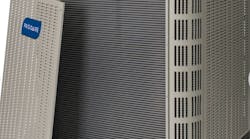During the past HARDI conference, wholesalers packed the two sessions dealing with 13 SEER. One of the concerns was the cost of the new equipment. How will this anticipated increase affect wholesalers and contractors? Will wholesalers and contractors simply pass along the costs for the new 13 SEER units?
MEIER: The biggest cost effect for the wholesaler is the increased cost to inventory. A 35 percent increase relates directly to increased carrying costs. As of today, we have simply passed on increases to the contractor.
YOUNG: We anticipate pricing to increase by 20 percent-30 percent over 10 SEER.
HENDERSON: Yes, we will have more investment in inventory and warehousing space. I also feel this is an opportunity for us and the contractor to increase gross margin dollars.
ZELLMER: There will no doubt be increased prices related to 13 SEER equipment and installation practices. While the equipment is physically larger in most cases, many models also include additional components (diagnostics modules, expansion valves, etc.). Installation practices may also affect the cost, as most manufacturers will want the indoor coil to be changed out with a new 13 SEER unit. However, the majority of the financial impact will be managed with better planning by the wholesalers and contractors on issues such as increasing their line of credit, improving financing available for customers and reconsidering their mix of inventory.
Wholesalers and contractors must pass those higher equipment/installation costs along; they should look at it as a chance to get paid for what they do and the better, quieter, more efficient equipment they will provide in a 13 SEER environment. They will need to ensure that the price point they set will support their business strategy. In doing so, they should not look at just sales dollars but look at units, as the higher cost/price per job might distort their typical measurements of success.
FOX: As a former wholesaler, I would expect wholesalers will eventually pass on the cost. Contractors are a little slow to pass on their cost increases to the end-user — the customer. Some contractors are definitely more price-sensitive because they're dealing directly with the consumer, and they face price resistance. Because contractors are in such a competitive environment, some may be unable to realize the percentage cost increase and then pass on the proper sell price increase quick enough to the end-user to protect their profit margins.
Indications are that wholesalers and contractors will also have increased handling, storage and shipping attached to the new units. How do you see the impact of these costs, and how will wholesalers or contractors respond to these issues?
MEIER: So far, there's not much difference in handling for our warehouse staff as far as shipping and receiving. There will be an increased cost to the customer that receives his material via common carrier since the weight has increased for 13 SEER along with the physical size. Storage space for the distributor is definitely a factor. You immediately need 35 percent-40 percent more space for every condensing unit. Coils and air handlers are also larger. We're fortunate that we have space available; however, I doubt that is common to most distributors.
YOUNG: There will be some additional costs to handle the new larger units: more trucks to unload, fewer units on delivery trucks, etc. We will need to raise our prices to cover the incremental handling costs. We have deep concern that some competitors will not analyze the situation properly and will erode our margins.
HENDERSON: We have increased our warehouse space by 15,000 square feet and are expanding four of our 16 branches. The contractors will rely more on our inventory instead of expanding.
ZELLMER: The new 13 SEER units are as much as 40 percent larger than 10 SEER units, which will impose a definite impact on logistics, warehouse space, material handling and equipment. The number of technicians needed on the job site may increase due to the logistics of installing larger systems as well as time on the job site due to indoor coil changeouts. It may be necessary to reconfigure trucks or add additional ones. Number of runs to the local distributor may need to be increased due to equipment sizing. Planning and communicating with others in the community will be beneficial, as there are many wholesalers and contractors who have some innovative ideas to effectively manage some of these logistical concerns. For instance, one contractor has considered adding small flat trailers on his service vans to carry additional equipment versus investing in new trucks.
FOX: On the contractor's side, we're a very resilient group. We'll make the necessary adaptations; and we're dealing with one or two units at a time, so we'll respond by using the proper trucks to handle the product and installing any lifting devices that might be necessary. But if these units require additional handling costs, contractors will have to absorb them, pass it on to the customer or ask wholesalers to make more job site deliveries.
Is the end-user — the consumer — really aware that they will have to pay considerably more for a 13 SEER unit when a 10 SEER unit would have been less expensive just a few months earlier?
MEIER: We've decided that most consumers have no idea at all about what's happening. We've had quite a challenge just trying to educate our dealers and customers. It's going to be similar to the phase-out of CFCs. Customers heard it over and over, but most didn't pay attention until the prices began to soar. In the end, it was (and will be this time) the end-user/homeowner that absorbs all the higher costs.
YOUNG: Most consumers have no idea what it costs to replace an A/C system until they are shopping for one. If no one is bidding a 10 SEER alternative, I do not see much of a negative impact. Some customers may choose to repair instead of replace their current system.
HENDERSON: I don't believe they are informed. Some contractors have advertised “last chance for savings ads,” but not very extensively.
ZELLMER: Emerson Climate Technologies conducted a survey throughout 2005 showing that 90 percent of consumers do not know what a SEER rating is or that there is even a change pending. Never mind that the price will increase. On the positive side, they will be getting a unit 30 percent to 50 percent more efficient. In a time of rapidly rising energy costs, these 13 SEER systems will save the end-user money every year — this is a significant benefit.
We do expect there will be some pricing discrepancies in the early summer as there is a large stock of 10 SEER equipment still available. A savvy consumer will shop the price and notice the difference. A well-trained salesman can explain the difference in price and benefits.
FOX: I think most consumers, in the general sense, are not concerned about their comfort systems. They're only concerned when they face an expensive repair bill or have an urgent need to replace a unit or component. Of course, the one difference this winter could be the cost of fuel and that increase just might cause them to think about the efficiency of their units. Some experts are predicting double-digit increases in heating costs. That's not easy to ignore, so it might bring some awareness.
Wholesalers often provide the training or facilities for contractors. Are you confident that wholesalers will be able to meet the demand for training contractors on the new 13 SEER units?
MEIER: Although there's plenty of training going on, we believe that most of the training is going to happen at the counter during a sale. Many of our customers are one- and two-man shops that have not yet picked their direction.
YOUNG: I have no doubt that we will be able to handle this.
HENDERSON: Yes, we have already started, and most contractors have attended some type of training, either informational or technical.
ZELLMER: There have been considerable efforts by OEMs and wholesalers to revitalize training for 13 SEER and R-410A refrigerant. However, we are concerned that a large number of technicians are not as prepared to work on the 13 SEER equipment and installations as they should be. So many technicians and only so much time. We strongly recommend planning ahead to set enough time aside to get your people and your customers' technicians trained. Work with your manufacturers to bring in expertise. Make it a priority to provide training to your outside sales and countermen. Urge your customers to come in and receive the necessary training for 13 SEER equipment and installations. More training now means fewer issues later.
FOX: When I was a wholesaler, we were big supporters of training. We considered it an investment in our dealer base. I'm confident that wholesalers, especially those who are strategic thinkers and members of an organization such as HARDI, will provide what the market demands. I can see, for example, some of the training offered by manufacturers is a job that wholesalers now handle, and on the whole, they've done an admirable job. However, many contractors will need to have additional training as we move into R-410A require- ments, which is not too far off.
Are you concerned about mismatched units during the implementation of the new 13 SEER units? What happens when you have a new condenser with an old 10 SEER or even 8 SEER coil?
MEIER: Our company policy is going to be — 10 SEER, OK to use the old coil or air handler. We are going to insist on a coil change for 13 SEER. (There may be exceptions, but not if there's any doubt).
YOUNG: Dealers will be told that using old coils will void the warranty. I doubt that you will see much of this except perhaps on multifamily jobs where space is at a premium.
HENDERSON: Yes, we are. We are in the process of training our contractors to inform the consumer that the coil should be replaced. There will be a potential of more compressor failures if the coil is not replaced, and it also could affect manufacturer warranties.
ZELLMER: Yes, this is a big concern for the industry. At a minimum, with undersized, older indoor coils, customers won't get the efficiency and capacity that they paid for. In the worst case, significantly mismatched systems will cause refrigerant floodback during run cycles that will impact lubrication and reduce reliability of the compressor.
Also, check your OEM warranty policies, as they vary depending on the installation practices and the match of the indoor and outdoor sections. So, for best practice, it is recommended that the indoor coil be changed out whenever a new 13 SEER system is installed. This way, the customer gets the energy efficiency, comfort and other benefits they have paid for.
FOX: Well, if there's a mismatch, it will certainly affect the efficiency, capacity and performance of the unit. There is going to be more labor and finesse needed in order to put in 13 SEER evaporator coils. If people buy a 13 SEER unit, it will be up to the contractor to explain why one should avoid a mismatched unit and what problems might occur if you try to do it differently.
What changes has your company made because of the new 13 SEER units?
MEIER:
-
Revised our warehouse storage capacities.
-
Began a monthly dealer newsletter about four months ago to try to better prepare our customers
-
Decided to buy a large quantity of 10 SEER units for sales into 2006. We believe there will be a demand for these for changeouts.
YOUNG: Looking at expanding receiving hours to handle the increased trucking requirements.
HENDERSON: We have added more warehouse space. Management attended all information seminars that have been available and emphasized 13 SEER training for our contractors.
ZELLMER: We've redesigned more than 70 percent of our product line. Across Emerson Climate Technologies, we have invested an excess of $200M in capital and R&D. We have dedicated more than 100 engineers, sent out more than 3,000 samples for customer and field tests, and are launching more than 150 new products in 2005-2006. We have launched efforts to educate the public with radio, TV, newspaper and magazine articles discussing the 13 SEER regulations as well as provided significant amounts of material on getSEERious.com for homeowners and emersonclimatecontractor.com for contractors.
FOX: We're already in the high-efficiency market, installing 13 SEER and higher and 410A units. I think there's more of an adjustment on the new construction end. Builders are going to have to adjust to the higher price, the larger size, the weight of the unit and higher skill levels of installers to install 13 SEER or R-410A units.
Frank Meier is the president of Binghamton, NY-based Meier Supply Co. Inc. He is a former HARDI president.
Doug Young is the president of Grand Rapids, MI-based Behler-Young Co. He is a former HARDI president.
Royce Henderson is the executive vice president of Colorado Spring, CO-based Charles D. Jones & Co. He is the chair of HARDI's Habitat for Humanity Committee.
Karl Zellmer is the vice president, VP Air Conditioning Sales and Tech Support of Sidney, OH-based Copeland Corporation.
Blaine Fox is general manager of ServiceMark, a full-service HVAC and plumbing company with more than 170 employees operating in Delaware and Pennsylvania. He spent 15 years in the HVACR wholesale business before moving to the contracting side. He is on the editorial board of Contracting Business magazine.





